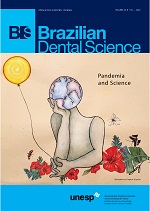Nanostructured platelet-rich plasma: state of art in dental treatments
DOI:
https://doi.org/10.14295/bds.2020.v23i2.1838Resumo
Objectives: Reviewing information available about platelet-rich plasma (PRP) applied to dental treatments, introducing the general concept of PRP, as well as analyzing actual data about, and challenges faced by, the dental field. Data & sources: The current study analyzed the most informative publications about PRP application available in this field and gathered the maximum information about it as possible. Conclusions: PRP use, either alone or in association with other biomaterials, can significantly favor different fields such as tissue engineering, since it is an innovative technique that attracts the interest of clinicians and basic scientists. However, it is necessary conducting better designed and controlled experiments to enable successful tissue healing based on PRP use. Clinical significance: The current review can be used by clinicians as source of information about the actual rules and protocols adopted in the herein addressed field, besides providing specific examples of such applications.
Keywords
Platelet-rich plasma; Dental treatment; Plateletgrowth factors; Nanotechnology; Bone regeneration; Surgery.
Downloads
Downloads
Arquivos adicionais
Publicado
Como Citar
Edição
Seção
Licença
TRANSFERÊNCIA DE DIREITOS AUTORAIS E DECLARAÇÃO DE RESPONSABILIDADE
Toda a propriedade de direitos autorais do artigo "____________________________________________________________________" é transferido do autor(es) para a CIÊNCIA ODONTOLÓGICA BRASILEIRA, no caso do trabalho ser publicado. O artigo não foi publicado em outro lugar e não foi submetido simultaneamente para publicação em outra revista.
Vimos por meio deste, atestar que trabalho é original e não apresenta dados manipulados, fraude ou plágio. Fizemos contribuição científica significativa para o estudo e estamos cientes dos dados apresentados e de acordo com a versão final do artigo. Assumimos total responsabilidade pelos aspectos éticos do estudo.
Este texto deve ser impresso e assinado por todos os autores. A versão digitalizada deverá ser apresentada como arquivo suplementar durante o processo de submissão.




























